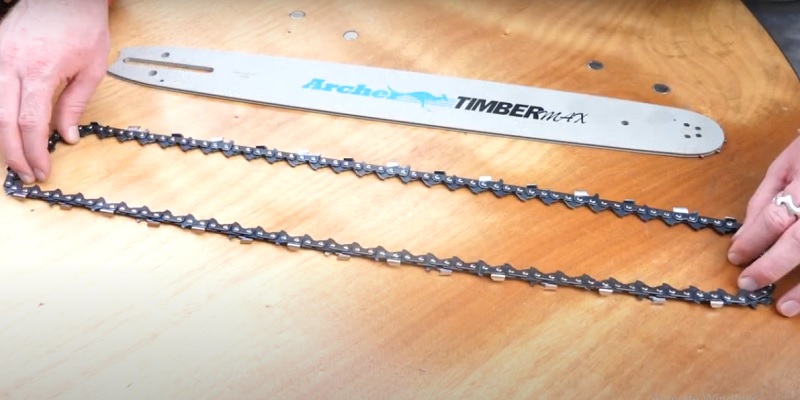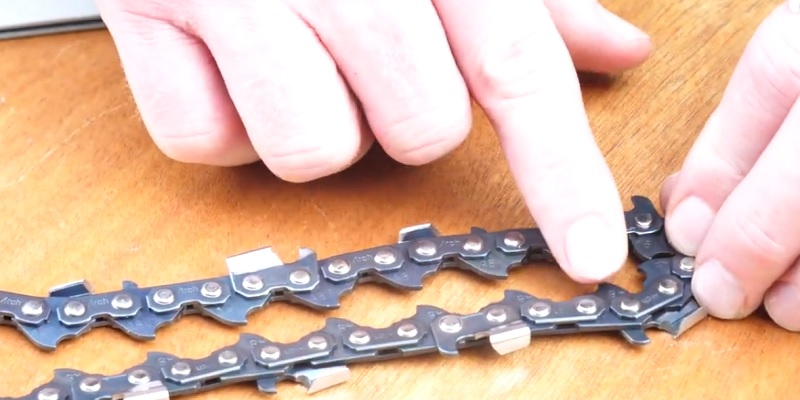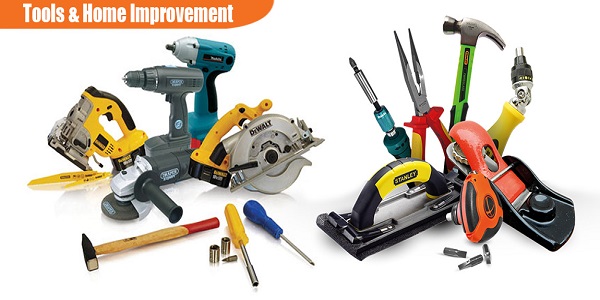To measure a chainsaw chain length, count its drive links. This simple method ensures you find the right replacement chain.
Chainsaw maintenance is crucial for smooth operation and safety. A properly measured chain is essential, whether you’re replacing an old one or buying a new chainsaw. Incorrect chain sizes can affect performance and may pose risks. Understanding how to measure the chain length will help you maintain your chainsaw effectively, ensuring it works efficiently.
This process involves counting the drive links and understanding the pitch and gauge. With this knowledge, you will avoid common mistakes and ensure your chainsaw is ready for any task. Let’s dive into the steps to measure chainsaw chain length accurately.

Chainsaw Chain Basics
Understanding the basics of chainsaw chains is crucial for anyone using this powerful tool. Whether you’re a seasoned pro or just starting, knowing the components and types of chains can help you select the right one for your needs. It also ensures you maintain your chainsaw efficiently, enhancing safety and performance.
Chain Components
A chainsaw chain is more than just metal links connected in a loop. It comprises several key components, each playing a vital role in its function. The main parts include the drive links, cutters, and guide bar length.
- Drive Links: These are the parts that fit into the guide bar and are crucial for the chain’s movement. Always count them to determine the correct chain length.
- Cutters: These are the sharp components that do the cutting. Keeping them sharp is essential for effective cutting.
- Guide Bar Length: This is the length of the bar that the chain wraps around. It’s typically measured from the tip to where it enters the chainsaw.
Getting familiar with these components can make chain maintenance less daunting. It also helps in troubleshooting issues like poor cutting performance.
Types Of Chains
Chains come in several types, each designed for specific tasks and saws. Choosing the right type can make your work faster and safer.
- Full Chisel Chains: These have square-cornered teeth, perfect for cutting through hardwood quickly. However, they dull faster, so frequent sharpening is necessary.
- Semi-Chisel Chains: With rounded corners, these chains are slower but stay sharp longer. They’re ideal for cutting softwoods or dirty, frozen wood.
- Low Profile Chains: These are often used by beginners or for smaller chainsaws. They are safer and reduce the risk of kickback.
Consider your specific cutting needs when choosing a chain type. Are you cutting hardwood or softwood? Is safety your top priority? These questions can guide your choice.
Have you ever struggled with choosing the right chain? Understanding these basics can make the process much easier and more effective.
Importance Of Accurate Measurement
Precise measurement ensures optimal chainsaw performance and safety. Measure from the tip of the bar to the point where it enters the motor. This helps maintain efficiency and prolongs the chain’s lifespan.
Accurate measurement of your chainsaw chain length is crucial for various reasons. It ensures your chainsaw operates efficiently and safely. Misjudging the chain length can lead to costly mistakes and even dangerous situations.
Safety Concerns
Your safety should always be your top priority when using a chainsaw. A chain that is too loose or too tight can cause the chainsaw to malfunction. This can result in kickbacks or other hazardous situations.
Imagine working on a project, and your chainsaw chain suddenly snaps. Not only could this damage your equipment, but it could also harm you or others nearby. By accurately measuring the chain length, you minimize these risks.
Optimal Performance
A correctly measured chainsaw chain ensures your tool performs at its best. A chain that fits well cuts more efficiently and requires less effort from you. This means your tasks can be completed faster and with more precision.
Have you ever tried cutting wood with a dull or misaligned chain? It’s frustrating and time-consuming. Proper measurement avoids this, keeping your chainsaw running smoothly and extending its lifespan.
Accurate measurement of your chainsaw chain impacts both your safety and the tool’s performance. Next time you handle your chainsaw, ask yourself: Is my chain the right length? Ensuring it is could make all the difference in your project’s success.
Tools Needed For Measurement
Measuring the length of your chainsaw chain is crucial for maintenance and ensuring optimal performance. But before you dive into measurement, you’ll need to arm yourself with the right tools. While some tools are essential, others can make the process smoother and more precise. Let’s explore what you need to get started.
Essential Tools
First and foremost, a measuring tape is indispensable. Ensure it’s flexible, allowing you to wrap it snugly around the chain. A standard tape measure works, but a cloth one is even better for accuracy.
Next, grab a flat surface to lay your chain on. This will prevent any misreads due to uneven placement. A workbench or sturdy table is perfect for this task.
Also, have a notepad or a smartphone handy to jot down your measurements. You might think you’ll remember, but it’s always better to record them immediately.
Optional Accessories
Consider using a caliper for precise measurements. This tool helps measure chain thickness and pitch, which can be crucial for compatibility checks.
Another useful accessory is a digital chain gauge. It offers quick, accurate readings and can save time if you’re frequently measuring chains.
If you have a magnifying glass lying around, it can be helpful, especially if the chain markings are small or worn out. This might seem excessive, but clarity is key.
Have you ever struggled with chain measurement, thinking you had the right size only to realize your chainsaw didn’t fit? With these tools, you can avoid such mishaps.
Step-by-step Measurement Process
Determining the correct chainsaw chain length is crucial for optimal performance. A proper measurement ensures safety and efficiency during operation. Follow these simple steps to measure the chainsaw chain length accurately.
Preparation Steps
Before measuring, gather necessary tools like a measuring tape or ruler. Ensure your chainsaw is off and the chain is cool to the touch. Lay the chainsaw on a flat surface for stability. Clean the chain to remove debris and ensure accurate measurement.
Measuring The Length

Begin by counting the number of drive links on the chain. These are small metal pieces that fit into the guide bar. Write down the total number of drive links. Next, measure the chain’s pitch. Measure the distance between three consecutive rivets.
Divide this number by two to find the pitch. Combine the pitch and the number of drive links to determine the chain length. This provides the complete measurement needed for replacement or maintenance.
Common Mistakes To Avoid
Measuring chainsaw chain length often confuses many. Ensure accuracy by counting drive links rather than guessing. Avoid using just the chain’s total length, as it can lead to errors.
Measuring the length of a chainsaw chain might seem straightforward, but there are common pitfalls that can lead to inaccurate results. Whether you’re a novice or have some experience, being aware of these common mistakes can save you time and ensure safety. Let’s delve into the details and help you avoid these common errors.
Incorrect Tool Usage
One frequent mistake is using the wrong tool to measure your chainsaw chain. A simple tape measure can work, but it may not provide the precision you need. Consider using a dedicated chain measurement tool or caliper for better accuracy.
During my early DIY days, I relied on a basic ruler. I ended up with an ill-fitting chain that was too tight. This taught me the importance of using the right tool. Have you ever struggled with a tool that wasn’t quite right for the job?
Misreading Measurements
Misreading the measurements is another common error. It’s easy to confuse the pitch or gauge of the chain, leading to incorrect sizing. Be sure to double-check the numbers and understand what they represent.
Reading from an angle can distort your view of the measurement, leading to errors. Ensure your eye level aligns with the measurement tool for accuracy. Remember, even a small discrepancy can affect the chain’s fit and function.
Taking the time to measure accurately can prevent frustration and ensure your chainsaw works efficiently. What steps will you take to ensure your measurements are spot on?
Tips For Ensuring Precision
Measuring the length of your chainsaw chain accurately is crucial for ensuring its performance and safety. Whether you’re a seasoned pro or a weekend warrior, precision in measurement can save you time and trouble. Here are some practical tips to help you measure your chainsaw chain length with confidence and precision.
Consistent Technique
Consistency is key when measuring your chainsaw chain. Develop a specific method and stick to it every time you measure. This might include using a tape measure or ruler to check the number of drive links.
Consistency helps eliminate errors and provides reliable results. If you always measure from the same starting point, you’ll avoid discrepancies. Have you ever faced the frustration of mismatched chain sizes? A consistent technique can prevent this.
Double-checking Results
Double-checking your results ensures accuracy. Measure twice to confirm your initial findings. It’s easy to miscount or misread measurements, especially if you’re in a hurry.
Consider using a template or reference guide for common chain sizes. This can act as a quick verification tool. Have you ever counted your drive links only to find the chain doesn’t fit? Double-checking can save you from such mishaps.
Precision in measuring chainsaw chains isn’t just about getting it right; it’s about maintaining safety and efficiency. By employing a consistent technique and double-checking your results, you ensure that your chainsaw is always ready for action. How do you maintain precision in your tasks? Perhaps these tips can enhance your approach.
Maintenance And Care For Chains
Maintaining a chainsaw chain ensures its longevity and efficiency. Proper care reduces wear and tear, enhancing performance. Regular inspections and careful storage are vital steps. These practices prevent damage and keep your chainsaw in peak condition.
Regular Inspection
Inspect your chainsaw chain for wear and damage. Look for signs of rust or dullness. Check each link for cracks or breaks. A damaged chain affects cutting ability and safety. Sharp chains cut efficiently and reduce strain on the motor. A monthly check helps catch issues early.
Proper Storage
Store chainsaw chains in a dry place. Moisture causes rust, weakening the metal. Use a protective cover to prevent dust and debris buildup. Hang chains on a wall to avoid bending. Avoid contact with other tools or surfaces. Proper storage extends the life of your chainsaw chain.
Choosing The Right Replacement Chain
Accurately measuring chainsaw chain length involves counting the drive links and measuring the chain’s pitch and gauge. These measurements ensure you select the correct replacement chain for optimal performance. Understanding these key factors helps maintain your chainsaw’s efficiency and safety.
Choosing the right replacement chain for your chainsaw is crucial to maintaining its efficiency and safety. A well-matched chain ensures optimal performance and reduces the risk of accidents. But how do you know which chain to select when there are so many options available?
Factors To Consider
When choosing a replacement chain, first determine the pitch, gauge, and number of drive links. The pitch is the distance between the chain’s links, typically marked on the tool or in the manual. The gauge measures the thickness of the chain’s drive links, ensuring a snug fit in the guide bar.
Consider the type of wood you’ll be cutting. Hardwoods demand a more robust chain, while softer woods can use a lighter chain. Also, think about the frequency of use. For daily use, a high-quality, durable chain is essential.
Top Brands And Models
Many users swear by Oregon chains, known for their durability and precision. Their chains are designed for a range of saws, ensuring a perfect fit. Husqvarna offers robust chains that are ideal for demanding tasks and professional use.
Stihl is another trusted brand, providing chains that are both reliable and long-lasting. Many professionals prefer Stihl for its consistent performance. Don’t overlook Echo chains for a balance of price and efficiency, especially for occasional users.
Are you loyal to a specific brand, or do you prioritize features and price? Exploring different models and reading user reviews can help you make an informed decision.
Frequently Asked Questions
How To Tell The Length Of A Chainsaw Chain?
Measure the chainsaw chain by counting the drive links and checking the pitch and gauge. Find the pitch by measuring the distance between three rivets and dividing by two. Determine the gauge by checking the chain’s thickness. Combine these numbers for the correct chain length.
How Do I Measure My Chain Length?
To measure chain length, lay the chain flat and count the number of links. For necklaces, measure end-to-end with a ruler. Ensure accuracy by laying it straight without twists.
How Do I Know What Size Chain I Need For My Stihl Chainsaw?
Check your chainsaw’s user manual for the correct chain size. Measure the bar length, pitch, and gauge. Count the drive links on the old chain for an exact match. Ensure compatibility with STIHL specifications for optimal performance and safety.
How To Measure Chainsaw Chain Pitch Without Ruler?
Use a coin to measure chainsaw chain pitch. Place the coin between three rivets, then check the diameter. Compare it to common chain pitches: 1/4″,. 325″, 3/8″, or. 404″. This quick method helps identify your chain size without a ruler.
Final Words
Measuring chainsaw chain length is important for safety and efficiency. Follow simple steps to ensure accurate measurement. Check the chain type and count drive links. Use a tape measure for precise length. Regular maintenance of your chainsaw chain is crucial.
It prevents wear and tear. An accurately measured chain offers better performance. Always prioritize safety while handling chainsaws. Use proper tools and techniques. Proper measurement leads to smooth operation. Keep your chainsaw ready for any task. Remember, a well-maintained chainsaw is a reliable tool.
Stay safe and efficient with your chainsaw.


